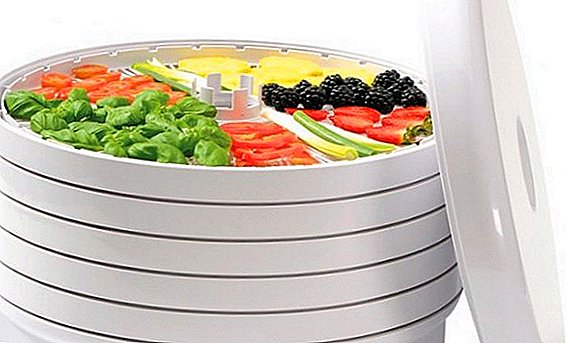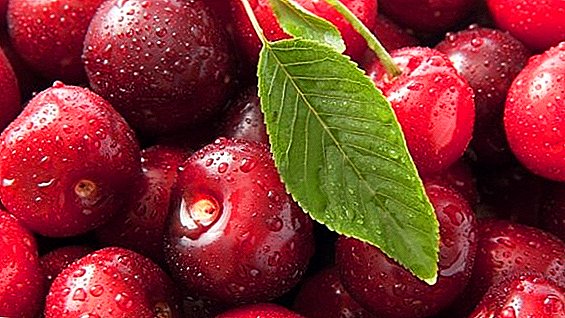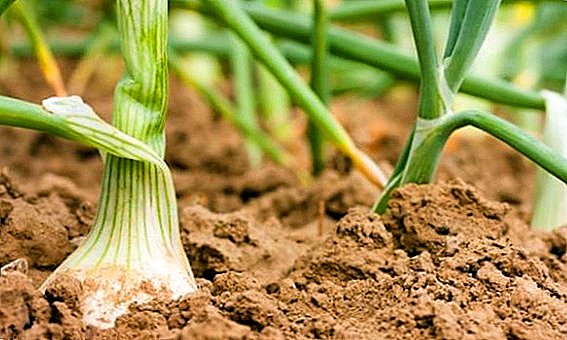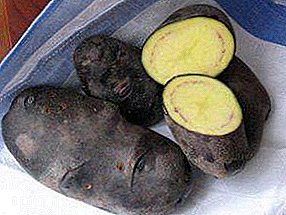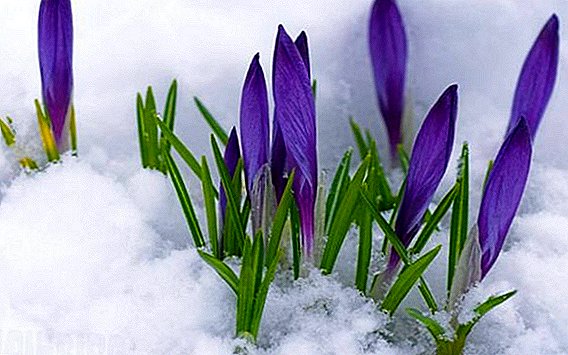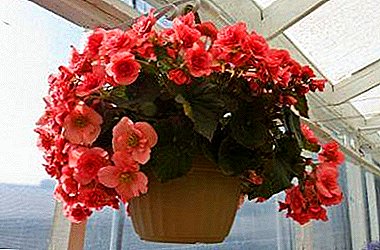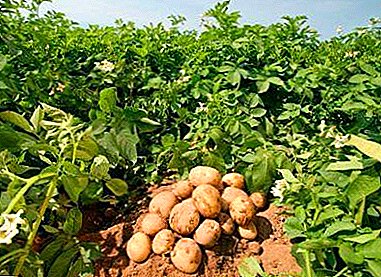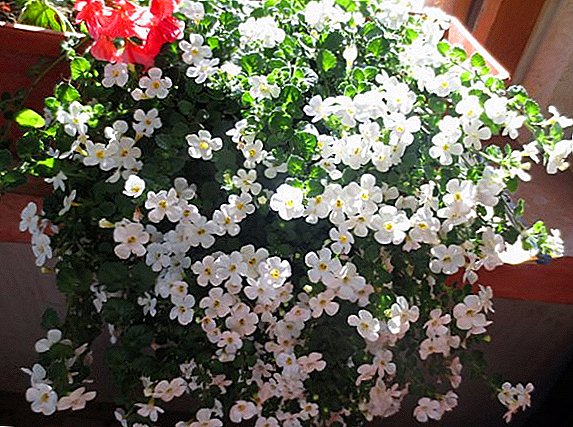Bacopa: plant description
 Usually we decorate our balconies, terraces or gazebos with such familiar colors as viols, petunias, nasturtiums. But it’s much more interesting to add something more rare and exotic to the composition. The flower recently imported from Europe, known to us under the name "suter" (Latin name - Bacopa) is an excellent option for such an experiment!
Usually we decorate our balconies, terraces or gazebos with such familiar colors as viols, petunias, nasturtiums. But it’s much more interesting to add something more rare and exotic to the composition. The flower recently imported from Europe, known to us under the name "suter" (Latin name - Bacopa) is an excellent option for such an experiment!
 The concept of "Bacopa" covers more than a hundred species of various plants that live in tropical and subtropical zones. The native territories of the suter are Australia, Africa, America, India, Asia, and the Canary Islands, but soon a quarter of a century, as a plant is cultivated by man.
The concept of "Bacopa" covers more than a hundred species of various plants that live in tropical and subtropical zones. The native territories of the suter are Australia, Africa, America, India, Asia, and the Canary Islands, but soon a quarter of a century, as a plant is cultivated by man.
The period of flowering in this culture lasts a long time, and the flowers of bakopa look very nice even after prolonged rains or other weather cataclysms, as the plant is cleaned of untidy, withered buds on its own.
In addition, it is, in general, unpretentious, which is justified by its increasing use in planting trees, decorating aquariums, and in landscape design, including decorating artificial ponds and waterfalls.
In appearance bakopa - This is a bushy plant with long stems, small paired leaves of bright green color and elegant white, blue or pink flowers located along the entire length of the shoot. The flowering takes place in several stages: it starts very plentifully, then the intensity slightly decreases and again resumes even more actively.
Bacopa shoots can effectively fall from a hanging pots or trail along the ground, rooting as you go. Certain inconveniences are caused only by the fact that the plant retains its decorative properties only during the first year of life, and in subsequent years it passes very weakly, so the bush needs to be updated annually. 
Did you know? In addition to decorative qualities, Bacopa has a more practical application: it is used in medicine, as well as in cosmetology.
Selection of varieties for growing plants Bacopa
The most common is bakopa with white flowers. However, selection experiments of recent years, conducted in different parts of the world, have enriched the look with numerous new variations: with enlarged colors, their changing shade, and also varieties with double flowers, etc. have already been bred. And this process is constantly ongoing!
To choose one or another variety of bacopa, you need to proceed from the place of use of the plant and the maximum possible conditions for its full development. So, hybrids with larger and velvety flowers are more capricious than traditional varieties.
Therefore, if you plan to use Bacopa in vertical compositions, it is better to purchase the most unpretentious option, since such a suter has long strong shoots, which, accordingly, will look great even with very small flowers.
If there is a desire to decorate an aquarium or a pond at the site, it is recommended to use a Karolinskaya (Bacopa carniniana) or Monier (Bacopa monnieri) variety suter the latter has creeping stems and white, red or blue flowers of very small sizes.  To decorate the terraces, balconies and open areas most often used varieties "Blutopia" with blue flowers and "Snowtopia" - with white.
To decorate the terraces, balconies and open areas most often used varieties "Blutopia" with blue flowers and "Snowtopia" - with white.
To help you in choosing, let's stop on several varieties of bacopa. For example, “Bacopa is beautiful” (the Latin name is Bacopa diffuses, as well as Vasora speciosa) is a beautiful dense bush of a rounded shape with long shoots covered with medium-sized single flowers of white, blue or pink hue.
In such varieties as Bacopa Snowflake and Cabana, the flowers are larger, and the Heart-shaped Bacopa (Bacopa cordata) has a very large number of inflorescences, with a pink, white or purple shade.
Choosing a place for bacopa
When choosing a site for disembarking Bacopa, it is necessary to proceed from the fact that the plant will best develop where there is no strong heat in the daytime, but enough light in the morning and evening. To protect the suter from the midday sun, you can use the natural shade that higher plants cast. In addition, it must be borne in mind that different varieties of bacopa react differently to excess sun. 
Temperature
Bacopa is adapted to sudden temperature changes, so it can be grown in open ground from spring to late autumn. However, it should also be borne in mind that frosts below five degrees of frost are already critical for the plant.
Lighting
The suter belongs to the light-loving plants, and the intensity of flowering directly depends on the amount of sunlight: in the penumbra, Bacopa will feel quite comfortable, but this mainly increases the green mass: the branches stretch out in length, and there will be much less flowers although sometimes in the shade of bacopa it does not bloom at all.
Plant substrate
 Bacopa does not differ in its particular demands on the composition of the soil, but most of all it is suitable for the soil with a weakly acid reaction (pH 6.5). In addition, the land must be enriched with organic matter and have good drainage.
Bacopa does not differ in its particular demands on the composition of the soil, but most of all it is suitable for the soil with a weakly acid reaction (pH 6.5). In addition, the land must be enriched with organic matter and have good drainage.
To grow a plant in open ground, it is enough to add peat to it, however, you should always remember that Bacopa grows better in flower pots, especially if you mix sand, humus and peat into the leaf substrate.
Landing Bacopa
Bacopa long shoots can be used both in vertical and in horizontal composition. In the first case, they can be directed upwards and strengthened so that a wall is obtained (for example, fixed over an area of a vertical grid or fence) or, on the contrary, hang a pot with a plant so that the shoots picturesquely fall in a free way. Horizontal planting allows you to make an excellent ground cover plant out of bakopa.
If the suter is grown in open ground, the landing should be carried out after spring frosts.
The distance between plants must be maintained on the basis of the size of the bush forms a particular variety. In any case, in order for him to feel free, it is necessary to leave around him a space with a radius of at least 10 cm, although in some cases it is useful to increase this distance.
 Landing technology simple enough. Small holes are made in loose and moist soil, after which drainage is filled in to prevent stagnation of water.
Landing technology simple enough. Small holes are made in loose and moist soil, after which drainage is filled in to prevent stagnation of water.
From above, this layer is slightly sprinkled with soil, and then the plant itself is placed in the well.
Next, the hole must be carefully sprinkled with earth and lightly tamped. Immediately after planting, the plant is watered abundantly, and afterwards it should be carefully monitored so that the soil always remains slightly damp, as the bacopa practically does not tolerate hardened and very dry soil.
Plant Care
Bacopa is an unpretentious plant, but to ensure abundant flowering and a spectacular appearance, adherence to certain rules is simply necessary.
Watering plants
Watering is perhaps the main thing that bacopa needs. Immediately after planting and during hot periods, the plant should be watered twice a day, while avoiding moisture on the leaves in sunny weather (the best time for watering is earlier morning and late evening).
 With great gratitude, Bacopa also responds to a refreshing sprinkle, which can also be carried out twice a day, although as soon as the plant begins to form buds, the shower must be stopped.
With great gratitude, Bacopa also responds to a refreshing sprinkle, which can also be carried out twice a day, although as soon as the plant begins to form buds, the shower must be stopped.
In the winter period, Bacopa falls into a state of rest, which means that at this time the plant should be watered only as the soil dries.
Fertilizer and dressing
During the period of active growth (spring-autumn), the bakopu should be fed three times a month with organic and mineral fertilizers (in turn).
From mineral supplements, preference should be given to potash and nitrogen, in addition, the plant needs manganese and magnesium for proper development. These elements will make bakopa leaves much brighter, and the plant itself - stronger.
Bacopa Trimming
An unformed bakopa with a small amount of shoots does not look too decorative. Therefore, for better bushiness and crown formation, the plant should begin to pinch immediately after rooting, repeating this procedure as it grows. Pinching is carried out at the growth points of the main and lateral branches.
 In addition, pruning Bacopa be sure to perform in the event that the shoots begin to grow too long in length. In such situations, the upper or lower parts of the branches become bare, and the plant will lose its decorative appearance.
In addition, pruning Bacopa be sure to perform in the event that the shoots begin to grow too long in length. In such situations, the upper or lower parts of the branches become bare, and the plant will lose its decorative appearance.
The maximum length of the shoot to ensure an attractive appearance Bacopa should not exceed 65 cm.
Picking a plant
Before the plant is planted in a permanent place, it is necessary dive bakopu. For the first time, this procedure is carried out after the rooting of the seedlings and the formation of the third true leaf. Young plants are transplanted in separate pots or in common boxes, but in the latter case the distance between the seedlings should be at least 2 cm.
The second picking of plants is carried out already in a permanent place - in pots or in open ground. At the same time, sowing seedlings into the soil is necessary for a full-fledged knot, because only in this case the plant will be better strengthened and bloom more abundantly.
After the first picking (after about a week), the seedlings can be fed with the same fertilizers as the adult plants, but the concentration of mineral substances should be two times less than usual. After the second pick, the fertilizer is carried out without observing such precautions.
 Before planting Bacopa in open ground, seedlings should always temper: if the optimum temperature for seedlings is from +22 ° C and higher, then some time before planting it is necessary to gradually reduce it to +15 ° C, and a few days before moving to the open ground to arrange for seedlings control “nights” at a cool temperature .
Before planting Bacopa in open ground, seedlings should always temper: if the optimum temperature for seedlings is from +22 ° C and higher, then some time before planting it is necessary to gradually reduce it to +15 ° C, and a few days before moving to the open ground to arrange for seedlings control “nights” at a cool temperature .
Wintering Bacopa
As it was said earlier, the suter does not tolerate severe frosts, therefore, winter bakopu can only be saved in a warm room. Moreover, if the plant in time (before the first frosts) to move to more favorable temperature conditions, it can continue to bloom until the New Year holidays.
After that, it needs to be cut and left in a bright and cool room (for example, on a closed balcony) until spring. The optimal temperature for wintering Bacopa is from + 8 ° C to + 15 ° C.
At this time, the suter is resting, almost does not grow and needs little watering. Nevertheless, the soil should not dry out, as for air: if it is not moist enough, periodically the plant should be sprayed.
Important! If you leave Bacopa for the winter warm, it begins to dry out, shed its leaves and stretch its length, and in addition, under these conditions, the plant is susceptible to soot and fungus and gray rot.

Second-year Bacopas bloom poorly, so at the end of winter, the plant should be rejuvenated radically, cutting off the cuttings and planting them separately to obtain new copies.
Reproduction Methods
The bakopa is a plant which reproduction is carried out by seeds or shanks (layers).
Vegetative methods
Bacopa grafting is considered to be the best way to grow a plant, as it is quite difficult to grow bakopa from seeds. The procedure should be started either at the end of winter and early spring, or in the fall, when you need to get rid of too long stems.
Rooting of pruned cuttings carried out, deepening them in wet sand or loose soil. To improve the effect, you can first put the cuttings in a container with water, and plant in a container only after the appearance of the first roots (usually this happens closer to the third week).
 If the stalk of a white "shallow" suter, for rooting it is enough just to stick it in the ground, then more exotic varieties require pretreatment with a growth inhibitor, as well as a greenhouse effect (covering the container with film), otherwise the plant will not take root.
If the stalk of a white "shallow" suter, for rooting it is enough just to stick it in the ground, then more exotic varieties require pretreatment with a growth inhibitor, as well as a greenhouse effect (covering the container with film), otherwise the plant will not take root.
Sprouted Bacopa cuttings can be planted in the open ground in late spring, when the earth finally warms up and frosts do not come unexpectedly. If, after landing, there is still a sudden cooling, young plants can be covered in order to avoid freezing.
Growing from seed
Bacopa seed sowing needs to start in winter, when the light day is gradually lengthening, and plants wake up after winter dormancy. It is not necessary to penetrate the seed material into the soil, since it is sufficient to superficially locate them on loose, moist soil and tamp slightly.
 The optimum temperature for germination is not below +18 ° C, although high air humidity is important for the success of the case. In general, to create the necessary conditions, it is better to equip an indoor greenhouse. The first shoots usually appear after ten days.
The optimum temperature for germination is not below +18 ° C, although high air humidity is important for the success of the case. In general, to create the necessary conditions, it is better to equip an indoor greenhouse. The first shoots usually appear after ten days.
Experienced gardeners recommend sowing bakopu in transparent containers, because the extra light accelerates germination.
Did you know? There is a somewhat unusual way of sowing seed bakopa. All the seed material is preliminarily calcined in the oven for four hours at a temperature of 100 ° C, then allowed to cool and laid out on a flat surface of the earth, covered from above with a dense layer of snow. After this, the construction is covered with a film or glass and exposed for germination on the window sill.As soon as the first shoots appear, they should be carefully watered (preferably by drip or spraying) so as not to damage the young shoots. If in two weeks the bacopa never sprouted, you will have to repeat the procedure from the very beginning.
Bacopa does not reproduce too well by sowing seeds, so this procedure can only be carried out successfully by experienced gardeners (with many nuances observed), and therefore it is worthwhile to first find the right video and get the necessary master class.
Important! Bacop, grown from seeds, has another unpleasant feature: they usually bloom with smaller flowers than the mother plant, while vegetative propagation methods do not lead to this effect.
Medicinal properties
 Bacopa has many medicinal properties, in particular, the substances contained in the plant have anti-inflammatory, antiseptic, healing, sedative, analgesic, rejuvenating, tonic, as well as antioxidant, diuretic and astringent effect.
Bacopa has many medicinal properties, in particular, the substances contained in the plant have anti-inflammatory, antiseptic, healing, sedative, analgesic, rejuvenating, tonic, as well as antioxidant, diuretic and astringent effect.
Thanks to these qualities of bacopa:
- protects and strengthens the walls of the stomach and blood vessels, neutralizes alcohol and normalizes acidity, improves blood flow, helps reduce cholesterol levels;
- positive effect on energy and plastic metabolism in the cells;
- stimulates the production of collagen necessary for the skin, slows down the aging process of the skin;
- kills many microorganisms that are carriers of sexually transmitted diseases, as well as diseases of the urinary tract;
- It has a positive effect on the central and peripheral nervous system, in particular: it improves memory, prevents the development of Alzheimer's disease, reduces stress intensity, stimulates cerebral circulation, etc.
Important! However, it should be noted that the medicinal properties of Bacopa have been little studied in humans, since, in general, the experiments were carried out on laboratory animals. In addition, it is noted that the most effective intake of Bacopa is when it is carried out in combination with other medicinal compositions of plant origin.There are also certain side effects when taking bacopa. In particular, a negative effect on the activity of spermatozoa has been observed, which means that taking medications based on bacopa reduces the ability of a man to conceive.
 It is not recommended to use these drugs and children under 16 years of age, pregnant and lactating women. In addition, you can not combine bacopa with sedatives or use for hypertension. Irritation of bacopa can also be caused when it is taken on an empty stomach.
It is not recommended to use these drugs and children under 16 years of age, pregnant and lactating women. In addition, you can not combine bacopa with sedatives or use for hypertension. Irritation of bacopa can also be caused when it is taken on an empty stomach.
Bacopa is a fairly new plant for our latitudes, but at the same time it is very beautiful and does not require special care. Its medicinal properties are still little studied, but the decorative qualities are beyond doubt.


